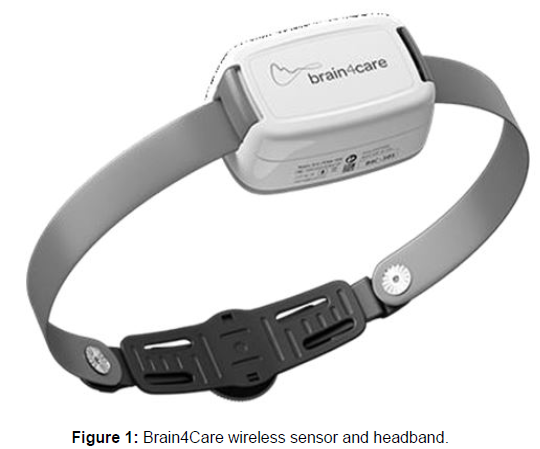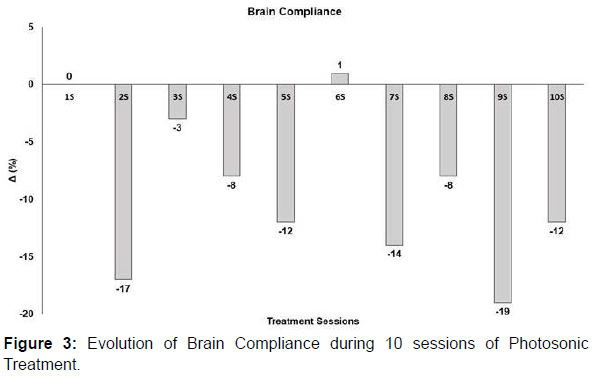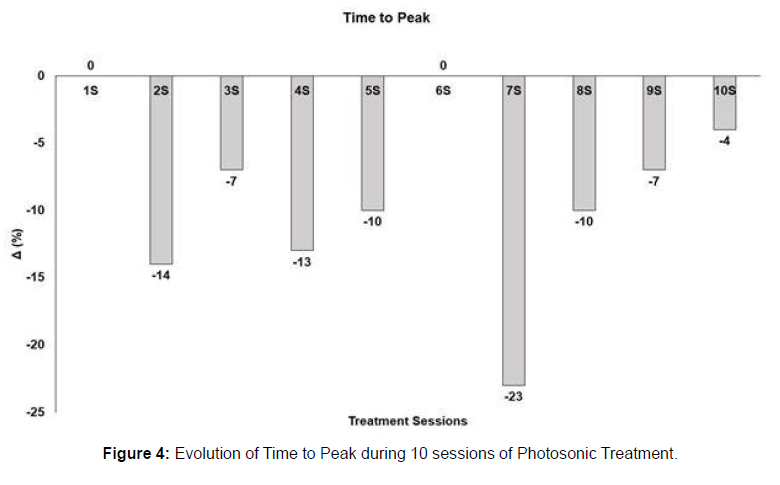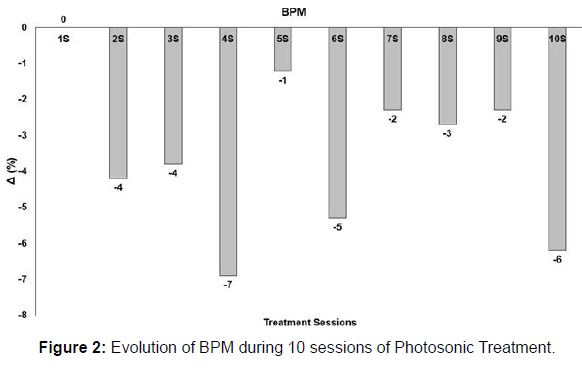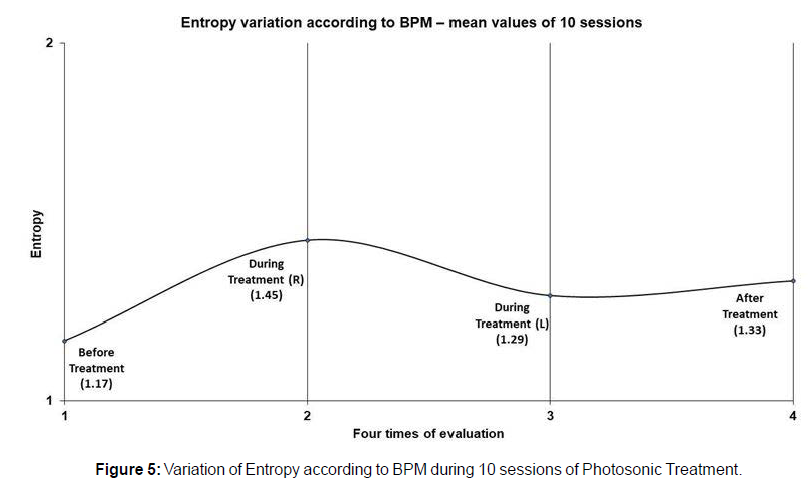Photosonic Treatment and Fibromyalgia: The Effect on Brain Compliance - Case Report
Received: 07-Mar-2022 / Manuscript No. jnp-22-56446 / Editor assigned: 09-Mar-2022 / PreQC No. jnp-22-56446 (PQ) / Reviewed: 23-Mar-2022 / QC No. jnp-22-56446 / Revised: 28-Mar-2022 / Manuscript No. jnp-22-56446 (R) / Accepted Date: 02-Apr-2022 / Published Date: 04-Apr-2022
Abstract
Fibromyalgia is a painful and chronic syndrome that causes disabling pain, that involve conditions like anxiety, depression, mood changes, sleep disorders, irritable bowel, among other changes. Chronic pain is directly correlated with high blood pressure; also, pain can generate changes in both blood pressure and intracranial pressure. There are several treatments for fibromyalgia, where Photonic Treatment, which combines photobiostimulation and ultrasound, promotes a new treatment approach, applied to the palms of the hands, enabling systemic action. The intracranial assessment patient was measured aiming possible intracranial changes, according to compliance in the study of intracranial assessment of pressure study, developed by Braincare and Innovation SA. The results were evaluated before and after the photosonic treatment. They were carried out through large estimates, monitoring scale non-invasive intracranial by analysis variables Braincare and Innovation SA. The results show an evolution in the Visual Analogue Scale, indicating a reduction in intracranial pressure (-70%) and in the Fibromyalgia Impact Questionnaire, indicating a reduction in pain (-60.4%), where inversely proportional, it indicates an improvement in quality of life. The distribution of the P2 × P1, a time relationship for each session performed an entropy found in the BPM analysis before treatment, showed significantly different. Thus, this study found variations in intracranial pressure through the action of photosonic treatment, pointing to a significant improvement in the patient's general condition after applications, relating variations in intracranial pressure with possible changes relevant to the disease. Although these results are important and guide new actions, more studies need to be carried out.
Keywords
Introduction
Fibromyalgia is a painful and chronic syndrome that causes disabling pain, with associated conditions of anxiety, depression, mood changes, sleep disorders, irritable bowel, headaches, morning stiffness, paresthesias, hypersensitivity, among other changes [1-3]. Considered a disabling disease, its prevalence is increasing, ranging in the general population from 0.2% to 6.6%, among women from 2.4% to 6.8%. Also, among the urban population, between 0.7% and 11.4% and the rural population, 0.1% to 5.2% [3]. All this limitation promoted by the symptoms of fibromyalgia, directly interfere in the patient's lifestyle, as well as in their daily routine, whether in the family or professional environment [4], causing impacts on personal, social and professional life, significantly reducing the quality of life of the patient and their family [5, 6].
Materials And Methods
Approval and Location
This study was approved by the Research Ethics Committee and the National Research Ethics Committee through CAAE 13789319.5.0000.8148, following resolution 466/2012, being held at the Photodynamic Therapy Unit of the Santa Casa de Misericórdia de Sao Carlos. The project was coordinated by the Physics Institute of Sao Carlos, University of Sao Paulo, Sao Carlos, Sao Paulo, Brazil. This study had technical support from the Clinica MultFISIO Brazil®, Sao Carlos, Sao Paulo, Brazil.
Equipment and Patent
Equipment with the capability of combined emission of therapeutic laser and therapeutic ultrasound was used, developed by the Physics Institute of Sao Carlos, University of Sao Paulo and produced by the company MMOptics, patent number BR102014007397-3 A2.
Patient and Protocol
Female patient, Caucasian, 46 years old, weighing 97 kg and 1.61 m tall, body mass index 37.45 kg/m². The patient was admitted after excluding the diagnosis of rheumatic diseases such as osteoarthritis, lupus, arthritis or systemic psoriasis. The clinical picture of fibromyalgia was appointed by medical evaluation in 2017 (4 years). Painful complaints include pain in the lower and upper limbs, diffuse pain, in addition to fatigue, reduced muscle strength, bad sleep conditions potentiated by severe apnea (uses continuous airway positive pressure - CPAP equipment), headaches, stomach pain, irritable bowel, stress and depression. Due to her current condition, she finds herself unemployed. The patient still uses several medications, such as antidepressants, anticonvulsants and anti-epileptics, anxiolytics, vitamin D and folic acid. There is no physical exercise by the patient.
The protocol requested application on the palms of the hands, according to Aquino Jr, (2021) [23]. The parameters were: ultrasound at 1MHZ, frequency 100 Hz; Laser at 660 nm wavelengths, 100mW power and 60 W/cm2 irradiance. The duration of each session was 10 minutes, with 5 minutes in each palm [23, 24]. There were 10 sessions, two times per week.
Questionnaire and Scale
The patient was analyzed in the initial and final condition, before and after each treatment session. The International Fibromyalgia Questionnaire and the Visual Analogue Scale were used to assess the patient's evolution in terms of quality of life and pain scale criteria, respectively [23, 24]. Data normalization was performed using Δ, generating percentage values, expressed in:
"Delta Value (Δ) = (Initial value - Final value) / Initial value × (100)"
Monitoring of Intracranial Pressure
The assessment of intracranial compliance will be performed using Brain4care technology, which consists of a mechanical strain gauge attached to a mechanical device that comes into direct contact with the surface of the scalp in the frontal-parietal temporal region of the skull. The device can detect small skull oscillations resulting from ICP changes, without the need for invasive or surgical procedures. The device used only requires placement of a sensor superficially on the skin of the scalp just above the ear and below the protrusion of the skull that is held in place by a clean, comfortable and adjustable plastic strap that does not pose a risk. The patient will be continuously monitored for signs of discomfort and, if present, the device will be immediately adjusted or removed [27, 28]. The assessment of intracranial pressure was performed in the periods of 5 minutes before the intervention, 10 minutes during the intervention (with 5 minutes of intervention in the palm of the right hand and 5 minutes in the palm of the left hand) and 5 minutes after the intervention (Figure 1).
Statistical Treatment
Comparisons between before treatment and after treatment conditions were used percentage (Visual Analogue Scale, Fibromyalgia Impact Questionnaire, Brain Compliance, Time to Peak and BPM) relationships developed through the equation:
"Delta Value (Δ) = (Initial value - Final value) / Initial value × (100)"
Comparison between 4 stages of evaluation, before treatment, during treatment in the right hand (R), during treatment in the left hand (L) and after treatment, a statistical analysis was performed using Instat 3.0 Software for Windows 7 (Graph Pad, San Diego, CA, USA, 1998). The data were expressed as mean and standard deviation. To analyze data normality, the Kolmogorov-Smirnov test was used. After, two way ANOVA with post-hoc-Tukey-Kramer was used to compare evolution. The level of significance adopted was p < 0.05.
Results
The present study compares the situations before photosonic treatment and after photosonic treatment in a patient with fibromyalgia. Assessments were performed using a questionnaire, pain scale and noninvasive intracranial pressure monitoring variables through the analysis of intracranial pressure wave morphology Braincare and Innovation SA. Table 1 shows the evaluation before treatment, after treatment and the delta of the variation between them, generating percentage values. It is possible to observe the great evolution in the Visual Analogue Scale, and a reduction in pain (-70%) and in the Fibromyalgia Impact Questionnaire, indicating a reduction of (-60.4%), where inversely proportional, it indicates an improvement in quality of life.
Comparison performed in actions before treatment and after treatment, considering the variables of the Visual Analogue Scale and Fibromyalgia Impact Questionnaire. Values are expressed as a total value and percentage value, considering the Δ= ((final value - initial value)/ initial value × 100) (Table 1).
| Visual Analogue Scale | Fibromyalgia International Questionnaire | ||||
|---|---|---|---|---|---|
| Before Treatment | After Treatment | Δ (%) | After Treatment | Before Treatment | Δ (%) |
| 10 | 3 | -70% | 91 | 36 | - 60.4 |
Table 1: Analysis before and after photosonic treatment according to visual analogue scale and fibromyalgia impact questionnaire.
Table 2 allows the comparison of symptoms reported by the patient before treatment and after treatment. Thus, in 10 sessions, changes in sleep quality, stress level, headache, stomach pain, intestinal regulation and report of physical activity are described and positive changes pointed out after treatment.
Comparison performed in actions before treatment and after treatment in relation to changes experienced by the patient. Issues related to sleep quality, stress, headaches pain, stomach pain, bowel condition, physical activity (Table 2).
| Before Treatment | After Treatment |
|---|---|
| bad sleep | better sleep |
| high stress | Did not report stress |
| Headache | no headache |
| Stomachache | had no stomach pain |
| irritable bowel | regular bowel |
| does not do physical activity | Did a 5 block walk |
Table 2: Report of changes experienced by the patient before and after the 10 treatment sessions
Figure 2 illustrates the variation in beats per minute (BPM), performed by monitoring intracranial pressure, enabling an analysis of the percentage difference between the highest beat and the lowest beat found in each treatment session. The periods of before treatment, during treatment in the right hand (R), during treatment in the left hand (L) and after treatment are observed. We can observe that in 9 of the 10 sessions they had a reduction in heart rate during this process. Session number 1 did not show enough data for analysis. The values are expressed in percentage, considering the Δ = ((final value - initial value)/ initial value × 100).
Table 3 shows the distribution of the P2 × P1 ratio, under the conditions of before treatment and after treatment, showing the average percentage between sessions, observing the change in each session performed. The percentage conditions of the distribution of the relationship in situations P2 < P1, P2 ~ P1 and P2 > P1 were changed, being in the before treatment condition 50%, 48.14% and after treatment condition 1.86%, and 32.2%, 64.1% and 3.7%.
Ratio distribution of the P2 x P1 in before treatment and after treatment condition in 10 sessions. The percentual values were distributed in P2 < P1, P2 ~ P1 and P2 > P1 (Table 3).
Figure 3 shows the assessment of Brain Compliance, in the situation before treatment and after treatment, for each of the 10 sessions performed. Values are indicated as a percentage difference between the highest and lowest values found in the evaluation periods before treatment, during treatment in the right hand (R), during treatment in the left hand (L) and after treatment. It is possible to observe a reduction in Brain Compliance in 8 of the 10 sessions held. The first session did not get enough data for analysis. The sixth session showed a different performance due to severe climate change. The values are expressed in percentage, considering the Δ = ((final value - initial value)/ initial value × 100).
Figure 4 represents the evaluation of Time to Peak, in the condition of before treatment and after treatment, for each of the 10 sessions performed. Values are described as a percentage difference between the highest and lowest values found in the evaluation periods before treatment, during treatment in the right hand (R), during treatment in the left hand (L) and after treatment. A reduction in Time to Peak is observed in 8 of the 10 sessions held, in an extremely similar way to Brain Compliance. Session 1 did not obtain enough data for analysis. Session 6 showed a difference due to severe climate change, which is similar to figure 3. The values are expressed in percentage, considering the Δ = ((final value - initial value)/ initial value × 100).
Figure 5 shows the entropy found in the BPM variation in the conditions of before treatment, during treatment in the right hand (R), during treatment in the left hand (L) and after treatment. Although it is not possible to measure a significant difference, a fluctuation of entropy is observed in the conditions previously analized, being before treatment (1.17), during treatment in the right hand (1.45), during treatment in the left hand (1.29) and after treatment (1.33). Values are described as a mean between the 10 sessions found in the evaluation periods. The values are expressed in mean, considering the 4 stages of evaluation: before treatment, during treatment in the right hand (R), during treatment in the left hand (L) and after treatment. There was no significant difference.
Discussion
Fibromyalgia, with all its symptoms and disabling pain, is an increasing disorder that impacts the personal, social, and professional lives of patients [5, 6]. Thus, the development of new technologies, methodologies and means that promote a better understanding of fibromyalgia are necessary so that the quality of life of people affected by this disease is restored. Likewise, the quantification of intracranial variation in a non-invasive way is a valid resource and of great importance in the understanding of fibromyalgia, since pain can alter both blood pressure and intracranial pressure, which are related [7-9].
In recent years, the photosonic treatment developed by our group has shed new light on the treatment of fibromyalgia [22-24]. This treatment, with all the innovation of the synergy of ultrasonic and photonic resources associated with an application on the palms of the hands, has a high performance in relation to improving the quality of life and reducing pain, via a systemic effect [22-24], observed in table 1, with an improvement of 70% in pain and 60.4% in quality of life. The way of applying the photosonic treatment is based on findings by Albrecht (2013) [25], which shows the existence of a large number of nerve endings close to the blood vessels in the palms, in the hypothenar region in fibromyalgic patients. This fact was expanded by Aquino Jr (2021) [23], who pointed out that the entire extension of the palms is influenced by the photosonic treatment, expanding the initial view observed by Albrecht (2013) [25]. Thus, this region, which involves the thenar, hypothenar and aponeurosis muscles, comprises the nerve endings of the common palmar digital branch of the median nerve, superficial branch of the radial nerve, median nerve, palmar branch of the median nerve, palmar branch of the ulnar nerve, digital branch, palmar joint of the ulnar nerve, as well as the arteries of the deep palmar arch and the superficial palmar arch [23].
The treatment proposal takes into account the action of ultrasonic and photonic waves in a synergistic way, generating the overlap of the therapeutic fields, where there is the action of cavitation (ultrasound), allowing the increase of ionic and vascular permeability, as well as the stimulation of angiogenesis (ultrasound and laser) [19-21]. Still, there is the analgesic, anti-inflammatory (ultrasound and laser) and ATPforming (laser) action [20-21]. In this way, in order to start promoting systemic homeostasis, the stimulation performed in the palms of the hands are absorbed and conducted by afferent pathways to the central nervous system. At this point, we observe the P2xP1 relation, in table 3, where there is a redistribution of the relation, increasing from 48.14% to 64.1% the P2 ~ P1 relation and decreasing from 50% to 32.2% the P2 > P1 relation, in data before and after treatment. When the P2 × P1 ratio is in such a way that P2 is higher, there is a higher intracranial pressure than expected. The changes promoted by the treatment are also shown in figure 3, where the variation in intracranial compliance is observed during each treatment session. It is observed that in 8 of the 10 sessions, reductions in values are obtained. It should be noted that session number 1 was affected by not having enough data for analysis and session 6 was altered due to the wind chill being reduced by 12º Celsius on this day. The reduction of intracranial compliance observed in the treatment promotes diverse effects and is key for the following actions.
| Relation of P | Before Treatment | After Treatment |
|---|---|---|
| P2 > P1 | 50% | 32.2% |
| P2 ~ P1 | 48.14% | 64.1% |
| P2 < P1 | 1.86% | 3.7% |
Table 3: Ratio distribution of the P2 × P1.
At this point our theory expands, where elevated intracranial pressure should promote changes in peripheral and cerebral blood flow, as well as changes in pain threshold and skull base, directly over the vagus nerve. This negative action that generates a negative cascade is reinforced by the results of normalization of the pain threshold, present in the prefrontal cortex of the brain, shown in Table 1. Thus, there is a decrease in intracranial pressure (figure 3), indicated by the decrease in intracranial compliance and by the change in the arrangement of the P2 × P1 ratio (table 3). By decreasing intracranial pressure, it is easier for blood to reach the brain, which is indicated by the reduction of the variable “Time to Peak”, described in figure 4. It is possible to observe the similarity of figures 3 and 4, strengthening the action treatment as the cause of the reduction variation. This action results in the positive action of excitatory neurotransmitters and inflammatory cytokines in the cerebrospinal fluid [30, 31], as well as modulating the pain threshold return to normal. All the normalization carried out also promotes positive systemic effects.
In this way, it occurs through the action of the vagus nerve, located at the base of the skull, the conduction by efferent pathways to several important organs, such as heart, stomach and intestine. This fact is supported by the change in the description of symptoms (Table 2) and by the observed reduction in heart rate shown in figure 2. Thus, an action occurs via the parasympathetic nervous system, improving conditions such as sleep, ceasing headaches and stomach pains, reducing stress, regulating the intestines and decreasing fatigue (Table 2), stimulating actions in response to calm, satiety, rest and digestion. There is a decrease in stress, which can also be indicated by the decrease in beats per minute, with a brief bradycardia, present in figure 2. The regulation of the system also promotes a return of sensitive information from these organs back to the central nervous system (CNS), promoting a negative feedback, preventing a greater reduction than necessary for the reestablishment of homeostasis. All this, in a positive cycle, homeostasis of metabolic abnormalities occurs, where, due to the improvement in sleep quality, there is a consequent gradual reduction in fatigue, in addition to normalizing the action of deep tissue nociceptors [32, 33], contributing to thermoregulation. Therefore, it is necessary to understand the action of entropy in living beings, promoted by the action of the therapeutic resources used (figure 5). The action of entropy translates into promoting the disorganization of the system and consequent reorganization of it, promoting the transformation of the energy inserted in the living system (organism), causing, according to Karu (2010) [21], a positive action in the organism in a state of suppression or sick, generating actions and feedbacks that promoted systemic homeostasis. In figure 5, it is possible to observe the energy gradient, entropy causing disorganization, increasing the initial entropy from 1.17 to 1.45 and, in the sequence, the organism seeking homeostasis, varying these values to 1.29 and 1.33 at the end of the treatment, when observed the entropy in relation to beats per minute (figure 5). The alteration of the initial entropy shows the action of the energy inserted in the organism, through the physiotherapeutic resources, generating the absorption and consequently exchange with the environment (since the energy is transformed and not lost), helping in the homeostasis framework.
In this way, the systemic action of the photosonic treatment is completed, providing the body with a condition of homeostasis and, consequently, the return of the fibromyalgic patient's quality of life.
Conclusion
Photosonic treatment for fibromyalgia is increasingly the most efficient form of treatment for the patient, with systemic actions that promote homeostasis. The knowledge of changes in intracranial pressure as a possible cause of fibromyalgia anomalies sheds new light on the subject, in addition to strengthening this therapeutic action, which without pharmacological and invasive action, promotes an improvement in the quality of life and the possibility of return to social and professional normality.
Ethical approval
This study was approved by the Research Ethics Committee and the National Research Ethics Committee through CAAE 13789319.5.0000.8148.
References
- Gómez Argüelles JM, Maestú Unturbe C, Gómez Aguilera EJ (2018) Neuroimaging in fibromyalgia. Rev Neurol 67:394-402.
- Berber JSS, Kupek E, Berber SC (2005) Prevalence of depression and its relationship with quality of life in patients with fibromyalgia syndrome. Rev Bras Reumatol 45: 47-54.
- Marques AP, Espírito Santo AS, Berssaneti AA, Matsutani LA, Yuan SLK (2017) Prevalence of fibromyalgia: literature review update. Rev Bras Reumatol 57(4):356-363.
- Spaeth M (2009) Epidemiology, costs, and the economic burden of fibromyalgia. Arthritis Res Ther 11: 117.
- Kaplan RM, Schmidt SM, Cronan TA (2000) Quality of well-being in patients with fibromyalgia. J Rheumatol 27:785-789.
- Martinez J, Ferraz MB, Fontana AM, Atra E (1995) Psychological Aspects of Brazilian Women with Fibromyalgia. J Psychosom Res 39:167-174.
- Holwerda SW, Holland MT, Green AL, Pearson ACS, Pierce GL (2021) Dissociation between reduced pain and arterial blood pressure following epidural spinal cord stimulation in patients with chronic pain: A retrospective study. Clin Auton Res 31(2): 303-316.
- Bellienia CV, Burronib A, Perronea S, Cordellia DM, Nencia A, et al. (2003) Intracranial Pressure during Procedural Pain. Biol Neonate 84:202-205.
- Fernandes MV, Melo MR, Mowry FE, Lucera GM, Lauar MR, et al. (2021) Intracranial Pressure During the Development of Renovascular Hypertension. Hypertension 77(4):1311-1322.
- Borchers AT, Gershwin ME (2015) Fibromyalgia: A critical and comprehensive review. Clin Rev Allergy Immunol 49:100-151.
- Skaer TL (2014) Fibromyalgia: Disease synopsis, medication cost effectiveness and economic burden. Pharmacoeconomics 32:457-466.
- Higgs JB (2018) Fibromyalgia in Primary Care. Prim Care 45:325-341.
- Clauw DJ (2014) Fibromyalgia: a clinical review. JAMA 311:1547-1555.
- Matsutani LA, Marques AP, Ferreira EA, Assumpção A, Lage LV, et al. (2007) Effectiveness of muscle stretching exercises with and without laser therapy at tender points for patients with fibromyalgia. Clin Exp Rheumatol 25:410-415.
- Kwiatek R (2017) Treatment of fibromyalgia. Aust Prescr 40:179-183.
- Gur A, Karakoc M, Nas K, Cevik R, Saraç J, et al. (2002) Efficacy of low power laser therapy in fibromyalgia: a single - blind, placebo-controlled trial. Lasers Med Sci 17:57-61.
- Macfarlane GJ, Kronisch C, Dean LE, Atzeni F, Häuser W, et.al. (2017) EULAR revised recommendations for the management of fibromyalgia. Ann Rheum Dis. 76:318-328.
- Laroche F (2019) Fibromyalgia. Rev Prat 69(6):649-651.
- Hamblin MR (2017) Mechanisms and applications of the anti-inflammatory effects of photobiomodulation. AIMS Biophysics 4:337-361.
- Çitak-Karakaya II, Akbayrak T, Demirtürk F, Ekici G, Bakar Y (2006) Short and Long-Term results of Connective Tissue Manipulation and Combined Ultrasound Therapy in Patients with Fibromyalgia. J Manipulative Physiol Ther 29:524-528.
- Karu TI (2006) Mitochondrial mechanisms of photobiomodulation in context of new data about multiple roles of ATP. Photomed Laser Surg 28(2):159-160.
- Franco DM, Amaral Bruno JS, Zanchin AL, Ciol H, Bagnato VS, et al. (2018) Therapeutic Ultrasound and Photobiomodulation Applied on the Palm of Hands: A New Treatment for Fibromyalgia–A Man Case Study. J Nov Physiother 8.
- De Aquino Junior AE, Carbinatto FM, Franco DM, Amaral Bruno JS, Souza Simão ML, et al. (2021) The Laser and Ultrasound: The Ultra Laser like Efficient Treatment to Fibromyalgia by Palms of Hands -Comparative Study. J Nov Physiother 11(1):1-12.
- De Aquino Junior AE, Carbinatto FM, Fernandes AC, Franco DM, Lara AA, et al. (2021) The Combined Photobiomodulation and Therapeutic Ultrasound: How does the Efficient Treatment of Fibromyalgia by the Palms Promote a Prolonged Effect? J Nov Physiother 11(1):1-5.
- Brain4care Tecnologia Ltda (2019) Manual do usuário brain4care. São Carlos 53.
- Brain4care Tecnologia Ltda (2019) Guia de uso brain4care. São Carlos 39.
- Albrecht PJ, Hou Q, Argoff CE, Storey JR, Wymer JP, et al. (2013) Excessive peptidergic sensory innervation of cutaneous arteriole-venule shunts (AVS) in the palmar glabrous skin of fibromyalgia patients: implications for widespread deep tissue pain and fatigue. Pain Med 4:895-915.
- Ballestero MFM, Frigieri G, Cabella BCT, Sergio Mascarenhas S, de Oliveira RS (2017) Prediction of intracranial hypertension through noninvasive intracranial pressure waveform analysis in pediatric hydrocephalus. Childs Nerv Syst 33:1517-1524.
- Ocamoto GN, Spavieri Junior DL, Matos Ribeiro JA, Frigieri Vilela GH, Catai AM, et al. (2021) Noninvasive Intracranial Pressure Monitoring in Chronic Stroke Patients with Sedentary Behavior: A Pilot Study. Acta Neurochir Suppl. 131:55-58.
- Russell IJ, Larson AA (2009) Neurophysiopathogenesis of fibromyalgia syndrome: a unified hypothesis. Rheum Dis Clin North Am 35:421-435.
- Staud R, Robinson ME, Price DD (2007) Temporal summation of second pain and its maintenance are useful for characterizing widespread central sensitization of fibromyalgia patients. J Pain 8: 893-901.
- Staud R, Weyl EE, Price DD, Robinson ME (2012) Mechanical and heat hyperalgesia highly predict clinical pain intensity in patients with chronic musculoskeletal pain syndromes. J Pain 13: 725-735.
- Morf S, Amann-Vesti B, Forster A, Franzeck UK, Koppensteiner R, et al. (2005) Microcirculation abnormalities in patients with fibromyalgia - measured by capillary microscopy and laser fluxmetry. Arthritis Res Ther 7: 209-216.
Indexed at , Google Scholar , Crossref
Indexed at , Google Scholar , Crossref
Indexed at , Google Scholar , Crossref
Indexed at , Google Scholar , Crossref
Indexed at , Google Scholar , Crossref
Indexed at , Google Scholar , Crossref
Indexed at , Google Scholar , Crossref
Indexed at , Google Scholar , Crossref
Indexed at , Google Scholar , Crossref
Indexed at , Google Scholar , Crossref
Indexed at , Google Scholar , Crossref
Indexed at , Google Scholar , Crossref
Indexed at , Google Scholar , Crossref
Indexed at , Google Scholar , Crossref
Indexed at , Google Scholar , Crossref
Indexed at , Google Scholar , Crossref
Indexed at , Google Scholar , Crossref
Indexed at , Google Scholar , Crossref
Indexed at , Google Scholar , Crossref
Indexed at , Google Scholar , Crossref
Indexed at , Google Scholar , Crossref
Indexed at , Google Scholar , Crossref
Indexed at , Google Scholar , Crossref
Indexed at , Google Scholar , Crossref
Indexed at , Google Scholar , Crossref
Indexed at , Google Scholar , Crossref
Citation: Junior AEA, Carbinatto FM, Tomaz CSR, Bagnato VS (2022) Photosonic Treatment and Fibromyalgia: The Effect on Brain Compliance - Case Report. J Nov Physiother 12: 510.
Copyright: © 2022 Junior AEA, et al. This is an open-access article distributed under the terms of the Creative Commons Attribution License, which permits unrestricted use, distribution, and reproduction in any medium, provided the original author and source are credited.
Select your language of interest to view the total content in your interested language
Share This Article
Recommended Journals
Open Access Journals
Article Usage
- Total views: 3882
- [From(publication date): 0-2022 - Nov 15, 2025]
- Breakdown by view type
- HTML page views: 3258
- PDF downloads: 624

